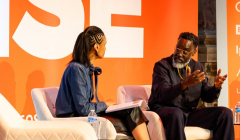
Create for consumers, don’t market at them
Speaking at the Creative Equals Rise conference, Ije Nwokorie, Chief Brand Officer at Dr Martens urged marketers to adopt a product-led mindset

Is it time that the industry gets more honest about what it takes to create genre-defining work?

With Cannes Lions well underway, the glitz and glamour of awards season gives agencies an opportunity to set foot on the beach, rosé in hand and bask in the success of their creativity. The advertising industry is second only to hairdressing when it comes to the sheer volume of awards shows.
Yet underneath the gloss of awards season can be years of hard work. Be it work that is a labour of love, projects that took blood, sweat and tears, or a breakthrough idea that came hand in hand with conflict and disagreement.
Behind the work that wins, the campaigns that are nominated and even the work that never gets a look in, is a creative process filled with ups and downs. A squiggly, rollercoaster of a creative journey pushed forward by teams made up of individuals that couldn't possibly all fit on the plane to Nice.
So as the industry descends on Cannes and agencies dust off their killer case studies; we are asking industry leaders if the shine of awards season glosses over the inherent frictions of effective creative processes. Often when you lift the lid on the most compelling and creative work there is a messiness involved which is key to growth. So do we need to be more honest about what it really takes to raise the bar creatively?

Friction sparks creativity. In order to win awards, we have to be brave enough to embrace a bit of friction.
Now, too much friction, or friction of the wrong kind, can be detrimental to the creative process. The goal isn’t to force heated debates. But if the end game is to create award-winning work, we first need to be comfortable with uncomfortable and challenging situations.
The goal is to use friction as a tool that forces questions about how a company or team is organised and the process that they use. Involving people who see things differently is the way to get new perspectives, grow as an agency and cultivate award-winning work.
What we’re ultimately looking for is creativity that works well with the new marketing realities and demands, yet still stand out. We need to meet the demands of both. Where function meets friction. That’s where the awards are.

As masters of messaging that sells brands, it’s no surprise that the creative industries excel at ‘awards spin’. Award entries are an art form in themselves. So much so, there’s probably merit in creating a category purely for the purple prose itself.
Award entry word-counts don’t usually leave space for the messy, behind-the-scenes challenges every campaign encounters. From goal-post-moving to alternating visions of success - to legal teams that love to hurl missiles at an idea until it’s reduced to a shadow of its former self; campaign planning is never complete plain sailing. And that’s before we consider budget woes, supplier issues, shifts in the zeitgeist… the list goes on.
There’s a case to be made though, for keeping that messiness under wraps. Like the public figures that we love to revere – until they do a tell-all and then we don’t (Hi Prince Harry), I personally enjoy the mystique. There’s a delightful ‘you know if you know’ element to the process that bands clients and agencies together, ride or die.
The process itself is the learning curve; allow us to feign perfection when it’s all over.

The awards culture, though valuable in highlighting exceptional talent and work across our industry, tends to propagate a polished image of the creative process, showcasing only the final destination from a long journey.
As we continue to learn throughout our careers, embracing risks is essential for growth and true innovation. Yet we only highlight work that embodies “perfection” rather than creativity. Challenging “perfect” helps us explore uncharted territories and push creative boundaries while avoiding a pattern of formulaic and predictable work. Celebrating perfection in this way can only lead to a decline in the ability to make a tangible impact of any kind.
While the industry continues to evolve, we need to understand that bold ideas are born from the blazing trail of dead ends that are essential to the growth process. By highlighting the struggles, embracing experimentation, and fostering collaboration, we can build a more realistic perspective on the creative process, leading to more meaningful and authentic work.

The creative process is messy. And deeply misunderstood. Creatives have to seamlessly think logically and use their subconscious to come up with relevant, innovative solutions. It is an emotional journey, often fraught with anxiety. I’ve seen people lose sleep worrying, oversleep to avoid and even create while asleep. I just pace, a lot.
The challenges are many. Recognising (and accepting) dead ends, dealing with omnidirectional feedback and my least favourite, battling mediocrity.
It takes a lot to keep us going. Awards provide inspiration. A shortcut in a time-pressured process to find the fuel we need. A desire to surpass what’s been done before. I call it a healthy creative jealousy. As a measure of quality, they offer a refreshing addition to client satisfaction and business results.
Deep in the trenches of the creative process, we know there is a chance that one day someone will be jealous of our idea.

Yes, in certain cases. We believe that the work has to be solving a real business problem - do that well and the award then follows. To do that you need time, belief and trusted partnerships. It also takes commitment. In the award shows you can see the ones which have clearly been done with the sole aim of picking up shiny metal. On the D&AD jury I was on recently we were looking at ideas and interrogating whether they had scale. One example case study talked up how the activity ran in 500 locations -but in a country with 1.4 billion+ people that lacks scale. Our No More Red work took a committed team 3 years to realise with the support of the whole agency for minimal fee because we believed in what it was setting out to achieve. And most importantly the brand and club were truly committed to being in it for the long term.
Looks like you need to create a Creativebrief account to perform this action.
Create account Sign inLooks like you need to create a Creativebrief account to perform this action.
Create account Sign in